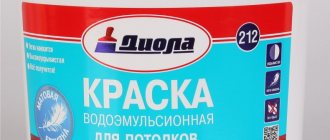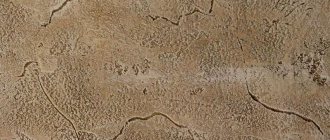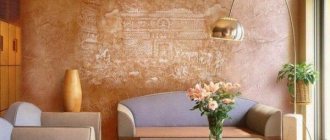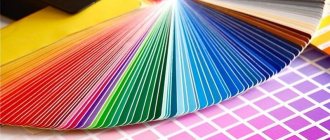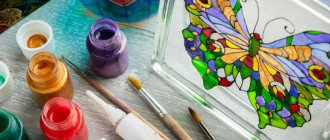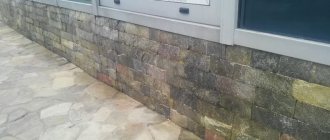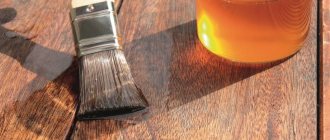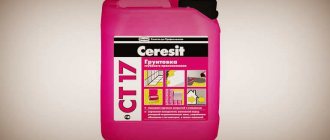Metal, metal tile and slate roofs require periodic painting, which not only improves the appearance of the structure, but also extends its service life, since the procedure is a good prevention of corrosion. Properly selected rubber roof paint makes it possible to avoid replacing this part of the building.
Characteristics of rubber paint for slate, application procedure and cost
Despite the large number of new roof protection materials, slate still remains one of the most practical, reliable and affordable. However, it has a significant drawback - under the influence of sunlight and temperature changes, its structure gradually deteriorates. To ensure protection, experts recommend using a special paint for slate, which, after drying, forms a rubberized layer.
Paint features, advantages and disadvantages
Visually, this paint is practically no different from the others. However, it contains special polymer components, thanks to which an elastic film is formed.
The main elements of the composition are acrylic and water. However, the addition of special rubber-containing components changes its properties. At its core, it is closer to polymer bitumen mastic than to painting materials. The difference is the low density of the substance (for uniform application over the slate surface) and various pigments - to give the composition a certain color.
Thanks to these ingredients, rubber slate paint has the following distinctive qualities:
- Increased mechanical strength due to surface elasticity. Even at low and high temperatures, the structure of the coating does not change.
- Low coefficient of dirt retention. Almost all debris will roll off the roof under gravity pressure.
- Durability. Depends on the chosen type of painting material and climatic conditions. For central Russia, the service life is about 8-10 years. And even after this time, only the shade of the coating will change slightly, maintaining its integrity.
- Has anti-slip protection. This is important when carrying out repair or maintenance work.
The application method is practically no different from other painting materials. However, choosing the right type of paint is important.
Application technology
The main limitation when choosing paint for slate will be the temperature. Since the roof is exposed to direct sunlight, its surface can heat up to 50-60°C. In winter, the air temperature can drop to -35 °C. That is why you should pay attention to this type of restriction when applying.
To maintain the color balance of the roof with the building, you need to choose the right paint color. In this case, you can choose a ready-made composition, or use coloring services. The choice of color pigments is quite wide. But often consumers use 15-16 colors.
You should know that there is a similar paint for the foundation of a house. However, its performance characteristics are not suitable for application to slate surfaces. Before purchasing, you should carefully read the instructions for use and the purpose of the composition.
Installation work should be carried out in several stages. First, the roof surface is prepared. It is cleared of debris and dirt, the presence of which can negatively affect the quality of the coating, then the integrity of each sheet of slate is checked. The specific property of rubber paint is to waterproof small cracks. But to prevent further spread of the defect, it is recommended to replace the entire sheet. Before starting work, you must carefully move the contents of the container. Adding other liquids to increase volume is strictly prohibited.
For better waterproofing and reliable protection, several layers of coating are applied. The thickness of each should not exceed 2 mm. Therefore, for work it is best to use special rollers with long pile. With their help, you can achieve uniform thickness over the entire surface. The next layer can be applied only after the first one has completely dried. The average drying time between layers is 1 hour.
If this technology is followed, the volume of paint consumption to form a two-layer coating will be about 300 g/m².
Manufacturers and cost
Several companies are involved in the production of rubber paints. The most famous of them are Tikkurila, Shikril and Bastion. The cost depends on the volume and composition. On average, for 1 liter you will have to pay from 400 rubles.
The choice directly depends on the quality of the slate, the financial budget and the amount of work. Almost all rubber paints have the same composition and performance qualities. When purchasing, you need to pay attention to the presence of a certificate, as there is a possibility of purchasing a fake. Most often, such situations occur in construction markets.
Slate processing process
After we have cleaned the work surface of excess dirt, we can begin processing the slate itself. This process includes the application of an antiseptic and hydrophobization. Antimicrobial substances will help kill parasites that live in microcracks in the material. Plus, it will prevent them from multiplying and spreading. You can do the treatment with a regular brush, but it will take longer and require a lot of effort. It is best to use a special sprayer. When antiparasitic treatment, be sure to wear gloves on your hands and glasses or a respirator on your face to avoid poisoning.
The slate surface becomes porous over time due to increased humidity, which leads to early damage and destruction. In order to improve the quality of the cover, hydrophobation should be carried out. These measures have a positive effect on the service life of the roof. Painting flat slate or any other type will help restore a neat appearance. It is best to carry out the procedure immediately after laying the material, but many developers do not think about this right away. They consider this option only in situations where the products have already lost their aesthetics. In the next section we will consider in detail this important and final stage of work.
Features of using rubber paint on slate
Quite a few users still use slate and its analogues as roofing in private housing construction. After all, such material is characterized by a long service life, reliability and resistance to aggressive environmental conditions. However, slate is a porous product that is destroyed under the influence of external factors, becomes actively polluted and covered with mosses or lichens. As a result, the aesthetics and presentability of the roof decrease noticeably. To create a protective layer, as well as to give a decorative look to such roof covering options, it is recommended to use products such as rubber slate paint. What is this product and how to use it correctly?
Why paint slate and is it possible to do it?
Naturally, you can paint slate. This will even improve its quality characteristics. Thanks to treatment with a coloring compound, a slate roof will be no worse than more expensive bright alternatives.
Slate is produced in the form of profiled sheets, panels and flat slabs. And any type of material can be painted, which will increase not only its decorative qualities, but will also have a positive effect on the operation of the material, and in particular:
- Protects the sheet from destruction.
- Will increase the service life of the finished coating.
- It will protect the coating from temperature changes, frost and moisture, and also increase their resistance to various types of loads.
- It will create a layer on which mosses and lichens cannot grow.
- Will reduce the release of asbestos into the environment.
If for some reason the paint comes off from a certain area of the slate on the roof, it must be reapplied, since slate is a porous material that absorbs water and is subject to contamination, as a result of which its appearance will very soon become obscene.
Rubber paint: characteristics and features
Rubber paints can easily help protect slate from precipitation and ultraviolet radiation, make the coating moisture- and frost-resistant, and also prevent its premature destruction. This material is an acrylic product with a water-soluble base. The peculiarity of the paint is that it has the consistency of mastic, and after complete drying it forms an elastic film resembling rubber on the treated surface. Moreover, the resulting layer can be easily bent, including at right angles, it is so plastic and flexible. Let's consider the main parameters of rubber paint compositions.
up to 2 hours at a temperature of 20-25 degrees and air humidity of 60-70%.
Due to its composition, rubber paint for slate has a fairly wide range of applications.
Scope of application
The positive properties of rubber paint and its technical characteristics make it possible to significantly expand the scope of use of this material. In particular, the product is used not only for painting slate and other roofing materials, but also for painting:
- swimming pools;
- showers;
- containers with water;
- facades;
- internal walls and ceilings;
- various buildings and structures, including furniture;
- running tracks, courts and other sports facilities where anti-slip coating is required.
This is a universal material that can be used when repairing roofs and walls, when creating a waterproofing coating, for painting cars, as road markings, for painting fences, terraces and balconies.
That is, it is recommended for materials such as metal, plaster, wood, chipboard, fiberboard, plasterboard, wallpaper, concrete, asphalt, aluminum, plywood, ondulin, brick, stone and so on. At the same time, the operating conditions of painted materials are quite varied. In particular, the product can be used in a humid environment and in a wide temperature range (from -50 to +60). These are far from the only positive qualities of this paint, which distinguish it favorably from other paints and varnishes.
Advantages of slate paint
The main advantages of rubber paint include:
- environmental cleanliness;
- vapor permeability;
- high elasticity, ductility and flexibility;
- wide scope of application;
- resistance to cracking and deformation of the finished layer;
- wear resistance;
- creating a waterproofing layer;
- heat resistance and non-toxicity;
- moisture resistance;
- frost resistance;
- resistance to mechanical stress;
- good adhesion to various surfaces;
- affordable price;
- long period of operation;
- ease of application and ease of maintenance.
If the application technology is followed, the material has no serious disadvantages.
The most popular paint brands
The market for paints for construction purposes is replete with brand names from the most famous manufacturers. However, which one is best for staining slate? Today, the following manufacturers are in high demand:
- Dahbeshikhtund. Paint from a German campaign, characterized by excellent performance properties. Of course, its cost is much higher than its domestic counterparts, but its quality makes it a leader. It has high adhesive properties, good strength, and long-term operation. It is recommended to use it for natural type tiles and slate.
- Polyfarb. A Polish-made product made on a dispersion basis. One of the features is the ability to dry quickly, which significantly speeds up the work process. Also, thanks to coloring, resistance to moisture and ultraviolet radiation increases.
- Aqua. The creators of the paint are the joint work of Finland and Sweden. It dissolves easily in water. A distinctive feature is resistance to alkaline environments. In practice, Aqua is used not only for painting slate surfaces, but also for concrete bases.
How to apply rubber paint correctly
The methods and methods of applying rubber paint are not very different from the use of other coatings. The whole process can be divided into three important stages.
- Preparatory stage. Requires careful surface preparation. The base should be cleaned of old coatings, corrosive formations, any dirt, dust, oil and grease stains, mold, mildew, and so on. It is also important to thoroughly dry the surface. It should be borne in mind that if the roof was previously covered with alkyd or oil compounds, then it is necessary to wash the surface with a detergent, sand it with an abrasive material, for example, sandpaper, or treat it with a special metal brush. Then rinse the base with water and dry thoroughly. Also at the preparatory stage it is worth using primers and primers for processing. It is especially important not to miss this procedure on highly absorbent materials. If you intend to paint products damaged by mold, then it is worth treating them with fungicidal and antiseptic agents.
- Main stage. Work may only be carried out under recommended environmental conditions. In particular, the weather should be dry and the air temperature should be from +10 to +30 degrees. Before application, slate roofing paint is thoroughly mixed and, if necessary, diluted with water. You can get a uniform painted layer using various tools. These may be hand-held products such as rollers and brushes or automatic spray equipment. To create a durable coating, paintwork should be applied in several layers, while the second and subsequent layers can be performed only after the previous one has dried. It is worth noting that rubber paint sets quite quickly; under suitable conditions, this time is no more than 60-120 minutes. Attention! It is not recommended to apply the composition in direct sunlight, in strong gusts of wind or in the presence of fog, as such factors may adversely affect the operation of the coating.
- The final stage. The instrument is washed with water after use. Leftover paint can be stored in a tightly closed container. If you need to dispose of the packaging, you can throw it away as construction waste. Do not pour paint into sewers or bodies of water.
Thus, you can see that applying the composition is quite easy, and you can do it yourself, which allows you to significantly save money on inviting professional painting teams. You can also reduce financial expenses by choosing the right product; for example, products from domestic manufacturers are not always inferior in quality to their foreign counterparts. It is only important to choose the right brand of paint.
How to care for a painted roof
After painting, the roof does not require special care.
The coating does not require special care, but it is important to inspect the treated surface every six months. If chips, rust stains or other damage are detected, restoration work must be carried out. Such procedures involve cleaning and degreasing the damaged area. If necessary, it is worth using a primer, sealant or a special anti-corrosion compound. Then apply a new coat of paint to the area.
If the coating has no defects, it is necessary to remove dirt, and wet cleaning will help with this. You can use antiseptic compounds, as well as soap solution. However, do not rub the material with hard brushes or abrasive powders, as this can lead to scratches and chips.
Attention! The first wash can be carried out only after a week has passed from the moment of painting, since it is this period that rubber compounds need to gain final strength.
When covering the surface with rubber paint, it acquires not only an aesthetic appearance, but also excellent performance. The painted product increases its service life and provides protection against mold, fungi, precipitation and other natural factors. In addition, this material is affordable and easy to install, which makes it an indispensable assistant in matters of repair and restoration.
Rubber paint for slate
LKM rubber paint CCCP is a new innovative rubber paint (almost liquid plastic), specially developed by our technologists to eliminate the shortcomings of conventional paints, including the widely advertised “rubber paints”, which are essentially ordinary high-quality facade paints.
The video shows a thick layer of rubber paint removed from a bucket. It is recommended to apply it layer by layer (in thin layers). Based on it, with specially developed additives, we produce and apply - LIQUID ROOFING (liquid rubber is quickly destroyed under the influence of ultraviolet radiation, our liquid roofing is not. It is successfully used , both as an independent coating and as a protection for liquid rubber)
Rubber paint for external and internal work is wear-resistant wholesale and retail, at the price of the manufacturer NPO LKM USSR. Rubber paint is especially durable. It is produced using the only especially durable latex in Russia (in fact, it is already latex, but a polymer) of its own production and development (material is patented, all materials posted on the site are prohibited from copying).
Any color according to the RAL, NSC catalog (the price is calculated individually). Delivery throughout Russia is inexpensive. For large orders, delivery by the company’s fleet of vehicles is possible. 23 standard colors.
— Concrete floors of parking lots, garages, warehouses — Brick or concrete walls outside and inside the building, as well as walls made of fiberboard, chipboard, OSB or plasterboard — Roofs made of metal tiles, slate, corrugated sheets, and other similar materials — Water containers (rubber paint for swimming pools) - Decorative and protective painting inside wet and dry rooms - Surfaces over plaster and putty - Protective and decorative painting of facades and walls of buildings - Metal products and structures, rubber paint for wood and wooden floors, very durable.
Excellent properties:
— Odorless, does not contain toxic substances, can be used without ventilation in enclosed spaces — Acrylate, water-soluble, water-dispersible, vapor-permeable — Elastic, durable, completely waterproof, weatherproof, wear-resistant — Fireproof — Dries in less than one hour — Consumption when painting — from 150 to 500 g/m2
Before use, be sure to prime with diluted rubber paint (you get an excellent hardening primer that you can’t buy in a store), at the rate of 1 kilogram of paint per 500 grams of water.
Application:
— Rubber paint for wood for exterior use — Rubber paint for walls — Rubber facade paint — Rubber paint for metal for exterior use — Rubber paint for concrete — Rubber paint for swimming pools — Rubber paint for floors — Rubber paint for slate — Rubber paint for roofs and facades - Rubber paint for concrete floors - Wear-resistant rubber paint for external work - Rubber facade paint for plaster for external work - Acrylic paint for walls and ceilings
- Instructions:
- Surface preparation
The surface to be painted must be clean, level and dry. It is advisable to remove old surfaces (especially organic-based paints). Glossy surfaces, cement laitance and flaking areas are cleaned with a scraper or wire brush. The metal is degreased with white spirit. The surface is primed with diluted rubber paint.
Mix the paint thoroughly before use. The paint is applied with a brush, roller or spray gun at temperatures above 5C (with the exception of the frost-resistant modification, it reaches minus 15C).
Drying time: 1 layer and further layers, 1-24 hours depending on temperature and air humidity (at 20C it dries in 30-40 minutes). Full polymerization occurs after 72 hours. After drying, you can walk, but wash and drive a car not earlier than the specified period.
Rubber paint produced by NPO LKM USSR contains a zinc filler (as in zinc paint), which allows it to be used as an excellent anti-corrosion paint.
Rubber paint LKM USSR is the highest quality rubber paint on the Russian and foreign markets, and at a very affordable price.
We produce genuine, extra durable and reliable rubber paint. IMPORTANT! Widely advertised “rubber paints” (we will not name them by name) pass off ordinary latex facade paint as rubber paint. This leads to rapid destruction and waste of money. Of course, if you want, we can make ordinary cheap latex facade paint for 100 rubles and call it rubber...
Buy rubber paint, price from the manufacturer NPO LKM USSR, still quality - new life!
rubber paint for concrete rubber paint for concrete for exterior rubber paint for concrete for exterior use rubber paints for concrete wear-resistant rubber paint for concrete for floors rubber rubber paint for concrete rubber paint for concrete buy rubber facade paint for concrete rubber paint for concrete for exterior use wear-resistant rubber paint for facade works for concrete rubber paint for concrete for exterior facade paint for concrete for exterior rubber paint for concrete for exterior work rubber facade paint for concrete for exterior work rubber paint for concrete price rubber paint for concrete for floors wear-resistant epoxy paint for concrete acrylic paint for concrete which paint is better for concrete polyurethane paint for concrete rubber paint for walls for concrete buy rubber paint for concrete for exterior work is it paint for concrete rubber paint for brick concrete paint for concrete for exterior work price best rubber paint for concrete consumption of rubber paint for concrete buy rubber paint for concrete paint for concrete for floors buy rubber paints for concrete for interior work rubber paint for concrete surfaces rubber paint for concrete garage rubber paint paint for concrete paint for concrete wear-resistant price buy wear-resistant rubber paint for concrete paint for plaster concrete paint for painting concrete
Characteristics of rubber paint for slate, application procedure and cost
Despite the large number of new roof protection materials, slate still remains one of the most practical, reliable and affordable. However, it has a significant drawback - under the influence of sunlight and temperature changes, its structure gradually deteriorates. To ensure protection, experts recommend using a special paint for slate, which, after drying, forms a rubberized layer.
Paint features, advantages and disadvantages
Visually, this paint is practically no different from the others. However, it contains special polymer components, thanks to which an elastic film is formed.
The main elements of the composition are acrylic and water. However, the addition of special rubber-containing components changes its properties. At its core, it is closer to polymer bitumen mastic than to painting materials. The difference is the low density of the substance (for uniform application over the slate surface) and various pigments - to give the composition a certain color.
Thanks to these ingredients, rubber slate paint has the following distinctive qualities:
- Increased mechanical strength due to surface elasticity. Even at low and high temperatures, the structure of the coating does not change.
- Low coefficient of dirt retention. Almost all debris will roll off the roof under gravity pressure.
- Durability. Depends on the chosen type of painting material and climatic conditions. For central Russia, the service life is about 8-10 years. And even after this time, only the shade of the coating will change slightly, maintaining its integrity.
- Has anti-slip protection. This is important when carrying out repair or maintenance work.
The application method is practically no different from other painting materials. However, choosing the right type of paint is important.
Application technology
The main limitation when choosing paint for slate will be the temperature. Since the roof is exposed to direct sunlight, its surface can heat up to 50-60°C. In winter, the air temperature can drop to -35 °C. That is why you should pay attention to this type of restriction when applying.
To maintain the color balance of the roof with the building, you need to choose the right paint color. In this case, you can choose a ready-made composition, or use coloring services. The choice of color pigments is quite wide. But often consumers use 15-16 colors.
You should know that there is a similar paint for the foundation of a house. However, its performance characteristics are not suitable for application to slate surfaces. Before purchasing, you should carefully read the instructions for use and the purpose of the composition.
Installation work should be carried out in several stages. First, the roof surface is prepared. It is cleared of debris and dirt, the presence of which can negatively affect the quality of the coating, then the integrity of each sheet of slate is checked. The specific property of rubber paint is to waterproof small cracks. But to prevent further spread of the defect, it is recommended to replace the entire sheet.
Before starting work, you must carefully move the contents of the container. Adding other liquids to increase volume is strictly prohibited.
For better waterproofing and reliable protection, several layers of coating are applied. The thickness of each should not exceed 2 mm. Therefore, for work it is best to use special rollers with long pile. With their help, you can achieve uniform thickness over the entire surface. The next layer can be applied only after the first one has completely dried. The average drying time between layers is 1 hour.
If this technology is followed, the volume of paint consumption to form a two-layer coating will be about 300 g/m².
Manufacturers and cost
Several companies are involved in the production of rubber paints. The most famous of them are Tikkurila, Shikril and Bastion. The cost depends on the volume and composition. On average, for 1 liter you will have to pay from 400 rubles.
The choice directly depends on the quality of the slate, the financial budget and the amount of work. Almost all rubber paints have the same composition and performance qualities. When purchasing, you need to pay attention to the presence of a certificate, as there is a possibility of purchasing a fake. Most often, such situations occur in construction markets.
paints and varnishes
Standard gray slate does not attract attention at all with its appearance. However, by painting it in certain colors that match your exterior, you can radically change your opinion about this material. Slate paint must have certain properties, including, first of all, its resistance to moisture and color change. Let's look at how to choose the right paint for slate below.
Table of contents:
Features and scope of use of slate
Slate is a fairly popular material for roofing. In addition, with its help it is possible to build fences for the site and even small outbuildings. Asbestos cement is used to make wave slate. With the help of special fibers, the mechanical resistance of slate is increased.
Slate sheets have a standard gray color. However, this material can be painted in almost any color or shade. This will improve not only its attractiveness, but also its performance characteristics.
In order to learn more about this material, we suggest that you familiarize yourself with its advantages and disadvantages. Let's start with the advantages:
- a successful combination of cement and asbestos significantly improves the strength of the slate covering;
- this roofing option heats up less from the sun than metal;
- the material is not susceptible to rust, has excellent moisture resistance and does not conduct electricity;
- during combustion the material does not emit toxic substances;
- slate has a long service life;
- the cost of such material is much lower than that of alternative roofing made of metal or corrugated sheets;
- slate is an excellent sound insulator - during heavy rain there is no noise inside the house.
Among the disadvantages of slate, we note:
- slate is quite fragile and can be easily damaged during transportation;
- The total weight of one sheet is about 18 kg, so at least two people will be required to lift it onto the roof.
As slate is exposed to moisture and temperature changes, it eventually begins to become covered with asbestos crumbs, resulting in the formation of microcracks and moss, which reduces its attractiveness.
In order to prevent this unpleasant factor, it is recommended to paint the slate. The paint will provide additional protection of the material from moisture, the formation of moss, and also increase the attractiveness of the appearance of the slate covering. Modern paints also contain antiseptic substances that prevent the development of mold and mildew. With their help, biological protection of the roofing is provided.
When planning to replace the old roof finish with a new slate one, we recommend that you first think about painting it. At the same time, it is recommended to carry out this work before installing slate on the roof.
Slate paint – features of choice and characteristics
In relation to the main active ingredient of slate paint, they are:
1. Acrylic or water-dispersion - this type of paint is applied to the slate surface previously coated with a primer. Acrylic paint for slate protects it from moisture and destruction, improves its sliding characteristics, thanks to which precipitation flows down the roof more easily. Acrylic-based paints dry quickly and come in a wide range of colors.
2. Paint for painting slate on an enamel basis - it is characterized by a high content of binders in its composition, has moisture-proof properties, and is resistant to precipitation. The coating, after painting, acquires additional strength characteristics. The pigments contained in the paint protect the coating from fading.
3. Slate roofing paint in the form of liquid plastic is a synthetic material with a bitumen, polystyrene or polyvinyl chloride base. These paints are affordable, however, compared to acrylic paints, this material has lower moisture-proof properties. In addition, such paints often contain substances harmful to human health.
4. Rubber slate paint is a fairly popular material for painting roofs. Among the advantages of rubber-based paint we note:
- high elasticity properties, when small cracks appear on the surface, the paint stretches without damage;
- the paint does not contain substances harmful to human health, it is non-flammable and has a high level of fire safety;
- provides slip protection, especially important when installing a flat roof;
- is highly resistant to wear and can last on the surface for many years;
- improves the performance qualities of slate - it is resistant to external irritants, fungus, corrosion and wetting;
- It is universal in use and has a varied color palette, so it will suit any exterior.
Using rubber paint to finish slate extends its service life several times. Slate becomes pleasant and attractive in texture. In addition, the paint perfectly waterproofs microcracks in slate. To ensure durability of the coating, it is recommended to apply rubber-based paint in at least two layers. It only takes a few hours for the paint to dry.
In relation to slate paint manufacturers, we note:
1. DachbeSchichtung - paint of German origin, has a high cost, which fully justifies its performance characteristics. The paint also has high adhesive properties, good strength, and long service life. However, this paint is suitable for coating natural tiles or slate.
2. Polyfarb is a Polish dispersion-based paint that dries quickly and has a rich color palette. The paint has good resistance to moisture and ultraviolet radiation.
3. Aqua is a Finnish-Swedish paint that dissolves with water and is resistant to aggressive alkaline environments. It is used not only for painting the code, but also for applying it to a concrete base.
Tikurila paint for slate: features of use and characteristics
“Tikkulira” offers paint for slate “KILPI”. It is an acrylate-based coating, diluted with water, which allows you to paint not only slate, but also bitumen roofing or concrete tiles.
With the help of this paint it is possible to significantly extend the service life of slate. In addition, it is highly resistant to solar radiation, moisture and other atmospheric influences.
Acrylate-based paint reduces the impact of moisture on slate coverings, making it possible to maintain its original appearance for many years. The paint contains special components that prevent the development of mold and mildew. The coloring composition does not lose its elasticity at both high and low temperatures.
Using Tikkurila slate paint, you can create a beautiful matte finish that resists the accumulation of dirt and dust. There are many colors for painting slate that will harmoniously match any exterior.
Is slate painted with paint: features of applying rubber paint
Before you start coating slate with rubber paint, you should prepare the surface. If there is dirt, grease stains, or dust on the slate, they must be removed. Since slate is a porous surface, it is necessary to coat it with several layers of primer. Thus, it will be possible to reduce paint consumption.
Use white spirit to degrease the surface. If the slate has already been painted, try to remove the paint. To apply paint, the air temperature should be from 15 to 30 degrees Celsius. At the same time, the maximum humidity permissible for performing work is 75%.
Before starting work, read the instructions for use of the paint composition. Next, open the container and mix the paint. Please note that diluting paint with drying oil or any other thinner is unacceptable.
If the paint has a high viscosity, then it is possible to add superprimer 100 to it, and then in a very small amount. To mix the paint, use a drill with a mixing attachment or a construction mixer.
To apply paint to the slate surface, a roller or pneumatic spray is used, in which case the surface is covered in several layers. While working, stir the paint periodically.
Features of choosing paint for flat slate
When asking what paint to paint the slate on the roof with, you must first decide on the type of slate used to finish the roof. Most often it is wave or flat slate. The following types of coloring compositions are suitable for one option or another:
1. Acrylic-based paints are environmentally friendly, dry quickly, adhere well to the coating, and also help create a smooth surface. Using this material you can quickly and easily paint any type of slate. The main rule for the high-quality operation of such a coating is compliance with all conditions from the manufacturer for applying the coloring composition.
2. Bitumen paint compositions are less popular due to their toxicity, although they are affordable.
3. Liquid plastic forms a protective coating on the surface of the slate, which significantly improves the service life of the slate.
4. Among the main advantages of silicone-based paints, we note:
- absolute harmlessness;
- long-term operation;
- good adhesion with slate.
At the same time, such compositions are quite expensive and have high consumption.
5. Oil-based enamels are also used in the slate painting process. They do not lose color over many years of use, they have quite rich and bright shades, but they take a long time to dry, approximately 5 hours.
6. Silicone-based slate paint - consists of silicone with the addition of dyes and various types of flooring substances. The material is quite durable and resistant to mechanical substances.
It’s up to you to decide which slate paint is best, but remember that in the process of choosing paint, you need to take into account the individual characteristics of the work.

